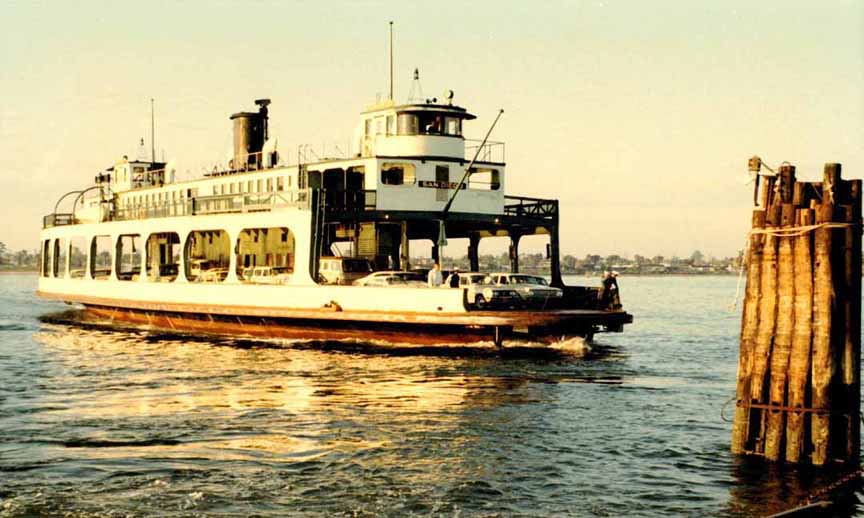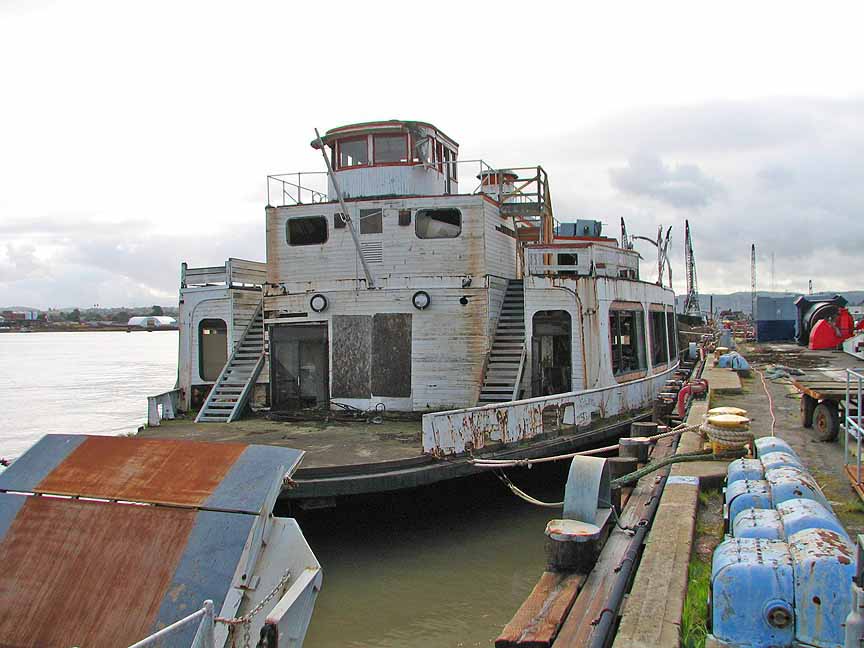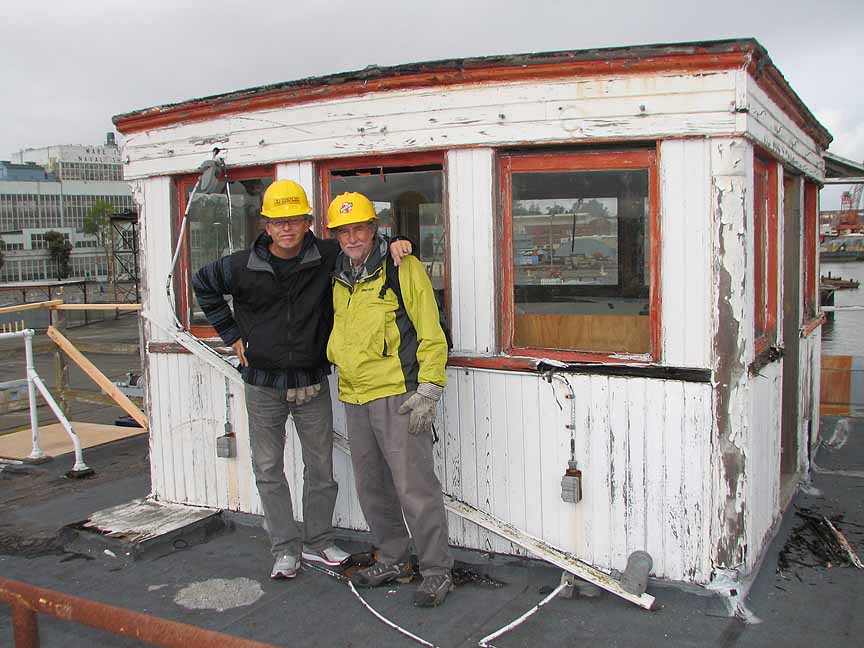CORONADO Like a scene from a low-budget film noir movie, the sky flashed with lightning, rain pelted down on deserted buildings and an old ferryboat pulled at her mooring lines with disappointment.
This was the scene at San Francisco’s Mare Island recently. The former San Diego-Coronado ferryboat, San Diego, had been designated as a hazard to navigation and scheduled for demolition. The old car-carrying ferryboat had operated here from 1931-1969.
It was one of five final boats delivering passengers and automobiles across the bay. All five ceased operation August 2, 1969 with the opening of the San Diego-Coronado Bay Bridge. They went their separate ways in various, failed business ventures. Today all but one has been destroyed or sank.
Coronado’s Debbie Riddle had fond memories from her childhood of riding the ferryboat San Diego. When she heard about the scheduled demolition, she convinced a Coronado historian to fly to San Francisco with the objective of photo-documenting the final days of the ferryboat San Diego. The results of which were to be housed in the Coronado Public Library as a permanent record of this very important chapter in Coronado history.
Riddle owns Lee Mather Co., Realtors, Coronado’s oldest brokerage (1953). She is no stranger to saving history. Last year she funded acquisition of a rare, complete set of 1903 Tent City Gazettes and donated them to the Coronado Public Library, providing a fresh look at another romantic era in Coronado history, the operation of Tent City (1900-1939).
The historian recruited for the ferryboat expedition was Joe Ditler, former marketing and promotions director at the Maritime Museum, past executive director of the Coronado Museum, and a veteran waterfront reporter.
Once a plan was put into place Ditler coordinated with Bruce Muirhead, a former Coronado resident now living in the Bay Area. The two arranged to visit the ferryboat and document her final voyage and last days.
The City of Coronado provided Ditler with a letter of introduction to the boat’s owners, the California State Lands Commission, to gain access to the ferryboat. They wanted not only to photograph the San Diego, but hoped to board her and select a few physical pieces of the ferry to bring back to Coronado for possible display at a later date.
“It was all very sad,” said Ditler of his visit to the ferryboat. “She had been a derelict for many years and it was difficult to imagine her former glory while looking at her condition today.
“Since leaving Coronado she had been the focus of numerous failed business undertakings. She had been occupied by a so-called artists’ colony, and had been on fire, adrift, abandoned, aground, and now was set to fall victim to the knackers’ torch.”
Ditler and Muirhead worked their way through piles of trash and carefully photographed her inside and out, marking a handful of items they felt might be worth salvaging before the wreckers turned-to with their heavy equipment the following day.
Thanks to financial assistance from Lee Mather Co., Realtors and the Bruce Muirhead Family, the following items were saved from the doomed ferryboat:
Two 20-foot Navigational poles?
Two lifeboat davit blocks
? Three lathed support columns from inside the passenger deck
? Two lathed railing posts from the outer passenger deck area?
Two eight-foot, 500-pound ventilation funnels from the upper deck
? One mooring cleat from the main deck bow
? And, one door latch from the aft pilothouse
“The demolition at the hands of the wrecking ball and knackers’ torch was just a ceremonial final gesture,” said Ditler. “The reality was that our old friend, the ferryboat San Diego, was already dead.”
Muirhead was also moved by the experience. “All I can say is that it was an emotional experience for both of us as we walked from deck to deck seeking something, anything that might be familiar to us from the ferryboat’s heyday and our youth in Coronado.”
Both men had vivid memories of the glory days of ferryboats in San Diego. Ditler had a special bond to the San Diego. It carried him to Coronado on his first trip here in 1965. He also rode it on its final run the last night of operation, in 1969, although the latter didn’t seem special at the time. “The last ride’ ended in San Diego and I had to hitchhike across the bridge to get home,” he laughed.
Some of the smaller artifacts have already been brought back to Coronado and are currently on display at the Coronado Public Library’s new exhibit on the Ferryboat Era. The larger ones will be trucked down in a few weeks.
“We are hoping the City of Coronado will be able to take the 25-foot navigational poles, restore them, and place them in Centennial Park in Coronado, where the original ferryboat ticket booth now sits,” said Ditler. “We feel that they will make an elegant and authentic addition to the existing tribute, which harkens to a very romantic time in our history.
“But once we were on the boat, it was like being a kid in a candy shop. We decided we also wanted samples of the woodwork (hence acquisition of the railing posts and support columns), and we realized the large ventilation funnels were in amazingly good shape so we grabbed them as well,” he said.
Gone were all the iconic items one might hope for on such a historic boat, said Ditler. Gone were the ship’s large wooden wheels (helms). There no longer was an engine room telegraph. The name boards that once identified her at every compass point had been pilfered.
The lifeboats and oars were gone, the bronze porthole covers, the brass whistles and whistle lanyards, the signage. Even the small brass engine room identification plates and christening plaques had been stolen, he said.
Newsman and historian Ken Kramer is doing a segment on the expedition to document the ferryboat San Diego for an upcoming edition of his TV show, “About San Diego.” That particular segment airs on KPBS TV, Thursday, May 31, at 8 p.m.
The Coronado Public Library has invited Ditler to speak on the topic and share images from the expedition. That is scheduled to take place in the library’s 150-seat Winn Room, May 10 at 7 p.m. The lecture is free of charge to the public, and seating is on a first-come basis.
The last remaining car-carrying ferryboat from the San Diego to Coronado run is the more modern Crown City, built in 1954. It didn’t have the large, upper deck passenger area its older sister ships had. The Crown City currently operates in Martha’s Vineyard under another name.
For more information contact Christian Esquevin, Director, Coronado Public Library, at [email protected], or call (619) 522-7395; or Joe Ditler at [email protected], or call (619) 742-1034.
The Ferryboat San Diego in her heyday, operating the watery route between Coronado and San Diego. Photo courtesy Coronado Public Library.
The 1931 ferryboat San Diego is no more. The boat had carried cars and people across San Diego Bay for 38 years. Photo courtesy Coronado Public Library.
The long, slow death of the ferryboat San Diego is complete. Today all that survives are a handful of items salvaged from the doomed boat and our memories. Photo courtesy Coronado Public Library.
Joe Ditler (left) and Bruce Muirhead aboard the ferryboat San Diego in San Francisco, just hours before the boat’s destruction. Photo courtesy Coronado Public Library.
A set of lifeboat davit blocks were salvaged from the ferryboat San Diego just prior to her demolition. The blocks held Lifeboat #2 on the ferryboat from 1931 until her demise in 2012. They are on display at the Coronado Public Library. Photo courtesy Coronado Public Library.
For more information contact Christian Esquevin,
Director, Coronado Public Library,
at [email protected], or call (619) 522-7395;
or Joe Ditler at [email protected],
or call (619) 742-1034.
——————————-









